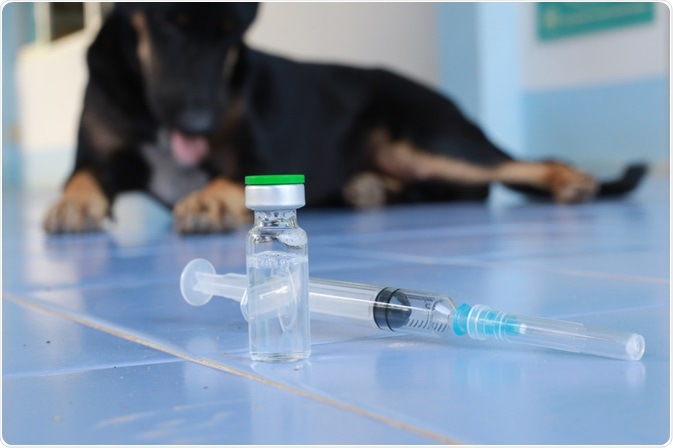Rabies is a viral disease that leads to the death of approximately 55,000 deaths worldwide each year. If individuals are exposed to the virus and prophylactic measures are not taken, the disease can be fatal.
The prevention of rabies is particularly important because it is usually too late to treat the virus by the time symptoms of the disease become recognizable. Instead, it is recommended that populations residing in or traveling to areas with a high risk of rabies take appropriate precautions to avoid the fatal effects of the disease.
This includes avoiding contact with animals possibly affected by the virus, as well as the appropriate vaccinations to prevent the virus from taking hold and causing the clinical condition.

Image Credit: Nomstocker / Shutterstock.com
Vaccination of domestic pets
At the beginning of the 20th century, the vaccination of all domestic pets became customary in many developed nations. This made a significant difference in the prevalence of rabies in the animals in these regions and helped to reduce the number of cases of humans with animal bites and suspected risk of rabies.
The vaccination of the majority of animals has led to a dramatic improvement in the number of rabies cases reported. This is evident when considering countries that have enforced this practice, such as in the United States of America and many European nations, where the incidence of rabies has steadily declined over the past century. Contrary to Asia and Africa, for example, where the risk of contracting rabies is much higher and these programs have not been enforced as attentively.
Caution in high-risk areas
As different areas of the world are associated with a higher risk of rabies, it is important for individuals in these high-risk areas, which can include residents or travelers, to take appropriate precautions to help in the prevention of rabies.
It is recommended to maintain some distance from stray animals in these areas and avoid petting or feeding them. Up to 40% of people who report an animal bite and suspected rabies are children under the age of 15, which is likely to be a result of them coming into closer contact with stray animals. Therefore, it is important that children living in or traveling to high-risk areas are properly educated about the risk of rabies and avoid close contact with unknown animals.
Additionally, for people traveling to high-risk areas, it may be appropriate to get vaccinated against rabies before traveling. This depends on the activities the individual plans to undertake during their trip; however, for many travelers, it can be a justifiable precaution to ensure a safer trip.
What is rabies?
Post-exposure prophylaxis vaccination
If an animal that is suspected to have rabies bites an individual, a series of vaccinations for post-exposure prophylaxis (PEP) is recommended. As symptoms usually develop when it is too late to treat the condition effectively, it is important for all at-risk individuals to be vaccinated after suspected exposure, regardless of whether symptoms are present.
PEP involves injections of rabies immunoglobulin and vaccines shortly after exposure to the virus, with four successive vaccines injected over the next 14 days. This technique is known to be extremely effective and has been estimated to help an estimated 15 million people with possible cases of rabies each year worldwide. To this end, these PEP measures prevent the disease and save the lives of hundreds of thousands of people annually.
Summary
If the appropriate precautions are taken, it is possible to prevent rabies from affecting the population. This involves a broad approach, including reducing the risk of rabies in an area by the vaccination of animals. For people in high-risk areas, close contact with stray animals should be avoided and, if bitten, PEP should be administered to prevent the virus from causing fatal results.
References
Further Reading